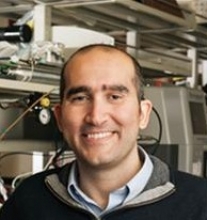ChEMS Seminar: Extracellular Electron Transfer in Multiheme Cytochromes and Bacterial Nanowires

Robert D. Beyer Early Career Chair in Natural Sciences
Department of Physics and Astronomy
Department of Biological Sciences
Department of Chemistry
University of Southern California
Los Angeles, California
In what has become an established pattern, however, our planet’s oldest and most versatile organisms are now challenging our current state of knowledge. With the discovery of bacterial nanowires and multicellular bacterial cables, the length scales of microbial ET observations have jumped by 7 orders of magnitude, from nanometers to centimeters, during the last decade alone! This talk will take stock of where we are and where we are heading as we come to grips with the basic mechanisms and immense implications of microbial long-distance electron transport. We will focus on the biophysical and structural basis of long-distance, fast, extracellular electron transport by metal-reducing bacteria. These remarkable organisms have evolved direct charge transfer mechanisms to solid surfaces outside the cells, allowing them to use abundant minerals as electron acceptors for respiration, instead of oxygen or other soluble oxidants that would normally diffuse inside cells. From an environmental perspective, these microbes are major players in global elemental cycles. From a technological perspective, microbial extracellular electron transport is heavily pursued for interfacing redox reactions to electrodes in multiple renewable energy technologies.
But how can an organism transfer electrons to a surface many cell lengths away? What molecules mediate this transport? And, from a physics standpoint, what are the relevant length, time, and energy scales? We will describe new experimental and computational approaches that revealed how bacteria organize heme networks on outer cell membranes, and along the quasi-one-dimensional filaments known as bacterial nanowires, to facilitate long-range charge transport. In addition, we will examine the fundamental limits of extracellular electron transport, down to microbial energy acquisition by single cells. These findings are shedding light on one of the earliest forms of respiration on Earth while unraveling surprising biotic-abiotic interactions.
Biography: Moh El-Naggar is the Robert D. Beyer Early Career Chair in Natural Sciences, and Assistant Professor of Physics, Biological Sciences, and Chemistry at the University of Southern California. As a biophysicist, El-Naggar investigates energy conversion and charge transmission at the interface between living cells and synthetic surfaces. His work, which has important implications for cell physiology and astrobiology, may lead to the development of new hybrid materials and renewable energy technologies that combine the exquisite biochemical control of nature with the synthetic building blocks of nanotechnology. El-Naggar was awarded the Presidential Early Career Award for Scientists and Engineers (PECASE) by President Obama in 2014. In 2010, El-Naggar received a Department of Defense Young Investigator Program (YIP) Award, from the Air Force Office of Scientific Research. In 2012, he was named one of Popular Science's ‘Brilliant 10’, the magazine's annual honor roll of the 10 most promising young scientists whose innovations will change the world. More information about El-Naggar's research can be found at http://nanobio.usc.edu
Share
Upcoming Events
-
EECS Seminar: Less Compute, More Intelligence – Efficient and Autonomous Generative AI and Agents
-
MAE 298: Microscopic Robots that Sense, Act and Compute
-
CBE 298 Seminar: Interface Modification for Electrocatalysis
-
CEE Ph.D. Defense Announcement: Machine Learning and Remote Sensing for Environmental Modeling - From Large-Scale Streamflow Forecasting to Malaria Risk Mapping
-
CBE Special Seminar: Operando Electrochemical Methods at Dynamic Energy Materials Interfaces
